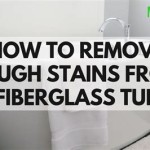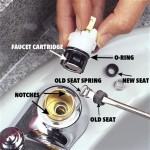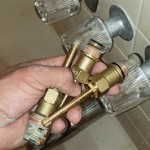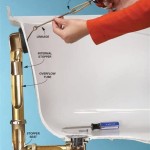How Bathtub Stoppers Work: A Comprehensive Guide
Bathtub stoppers are essential components of any bathtub, serving the fundamental purpose of retaining water within the tub for bathing. These seemingly simple devices employ various mechanisms to create a watertight seal, preventing water from draining until intentionally released. Understanding the inner workings of different bathtub stopper designs provides insight into their functionality, maintenance, and potential troubleshooting.
The basic principle underlying all bathtub stoppers is the obstruction of the drainpipe. This obstruction must be both reliable and easily reversible. To achieve this, manufacturers have developed several types of stoppers, each with its own unique design and operational characteristics. The selection of a particular stopper type often depends on factors such as bathtub design, plumbing configuration, and personal preference.
Pop-Up Stoppers: A Lever-Activated Mechanism
Pop-up stoppers, also known as lift-and-turn stoppers, are a common type found in many modern bathtubs. They operate via a lever or knob typically located on the overflow plate, which is the circular or rectangular plate near the top of the tub, often connected to the drain.
The functionality of a pop-up stopper is based on a system of linkages and a pivoting stopper. When the lever is in the "open" position, the linkages retract the stopper, allowing water to flow freely down the drain. This is achieved through a mechanical connection between the lever and a plunger located within the drainpipe. The plunger is connected to the stopper via rods and pivot points. When the lever is rotated or lifted, it causes the plunger to move vertically, which, in turn, retracts the stopper from the drain opening.
Conversely, when the lever is moved to the "closed" position, the linkages extend the stopper, pushing it downwards to seal the drain opening. The stopper itself is usually made of rubber or another flexible material to ensure a tight seal against the drain seat. The precision and alignment of the linkages are critical for proper operation. If the linkages become loose, misaligned, or corroded, the stopper may not seal properly or may become difficult to operate.
Adjustments to the pop-up stopper mechanism are often possible. Typically, a screw or adjustment nut is located on the linkage system, allowing for fine-tuning of the stopper's travel distance. This adjustment can be used to optimize the seal and prevent leaks. Over time, the rubber stopper itself may wear down or become deformed, requiring replacement to maintain its sealing effectiveness.
The overflow plate serves not only as an access point for operating the stopper but also as a safety feature. It allows excess water to drain away if the bathtub is filled beyond a certain level, preventing potential flooding. The overflow drain is connected to the main drainpipe, ensuring that any water entering the overflow opening is safely directed away.
Maintenance of pop-up stoppers typically involves cleaning the drain and stopper area to remove hair and debris that can accumulate and impede the sealing process. Periodic lubrication of the linkages can also help to ensure smooth operation and prevent corrosion.
Trip Lever Stoppers: Internal Plunger Operation
Trip lever stoppers resemble pop-up stoppers in their external appearance, featuring a lever located on the overflow plate. However, the internal mechanism of a trip lever stopper differs significantly. Instead of directly controlling the stopper with horizontal linkages, the trip lever controls a vertical plunger located within the drainpipe itself.
When the trip lever is activated, it moves the internal plunger up or down. The plunger is equipped with a rubber seal or flapper at its lower end. In the "closed" position, the plunger is lowered, and the rubber seal is pressed against the drain opening, creating a watertight barrier. The weight of the water above the stopper helps to maintain the seal.
To open the drain, the trip lever is moved in the opposite direction, raising the plunger and lifting the rubber seal away from the drain opening. This allows water to flow freely down the drainpipe. The simplicity of this design contributes to its reliability and ease of use.
The primary advantage of trip lever stoppers is their relatively simple construction. This simplicity translates to fewer moving parts and a lower likelihood of mechanical failure. However, the internal plunger can be susceptible to clogging from hair, soap scum, and other debris. Regular cleaning is essential to prevent blockages and ensure proper operation.
Adjustment of trip lever stoppers typically involves adjusting the length of the connecting rod between the trip lever and the plunger. This adjustment allows for fine-tuning of the stopper's sealing effectiveness. If the stopper is not sealing properly, adjusting the rod length can ensure that the rubber seal makes firm contact with the drain opening.
The overflow plate and drain function similarly to those in pop-up stopper systems, providing both an access point for operating the stopper and a safety mechanism to prevent flooding. Regular inspection and cleaning of the overflow drain are also important to maintain its functionality.
Repairing a trip lever stopper often involves replacing the rubber seal or flapper at the end of the plunger. Over time, this seal can become worn, cracked, or deformed, leading to leaks. Replacing the seal is a relatively simple and inexpensive repair that can restore the stopper to its original functionality.
Push-and-Seal Stoppers: Direct Pressure Activation
Push-and-seal stoppers, also known as toe-touch stoppers or foot-actuated stoppers, offer a more streamlined and minimalist design compared to pop-up and trip lever stoppers. They operate by applying direct pressure to the stopper itself, typically with a toe or foot.
The mechanism of a push-and-seal stopper is relatively straightforward. The stopper consists of a domed or button-shaped cap attached to a spring-loaded plunger. When the cap is pressed down, it compresses the spring and pushes the plunger downwards. This movement causes a rubber seal located on the underside of the cap to engage with the drain opening, creating a watertight seal.
To release the stopper, the cap is pressed again. This action triggers a release mechanism within the stopper, allowing the spring to push the cap upwards and lift the rubber seal away from the drain opening. The stopper typically alternates between the "open" and "closed" positions with each press.
One of the key advantages of push-and-seal stoppers is their ease of use. They require no external levers or knobs, making them particularly convenient for individuals with limited mobility. The streamlined design also contributes to a cleaner and more modern aesthetic in the bathroom.
However, push-and-seal stoppers can be more susceptible to clogging than other types of stoppers. Hair, soap scum, and other debris can easily become trapped beneath the cap, obstructing the sealing surface and preventing the stopper from sealing properly. Regular cleaning is therefore essential.
Maintenance of push-and-seal stoppers typically involves removing the cap and cleaning the area beneath it. Some push-and-seal stoppers are designed with a removable strainer basket to catch hair and debris, making cleaning easier. Periodic lubrication of the moving parts can also help to ensure smooth operation.
Troubleshooting push-and-seal stoppers often involves addressing issues related to clogging or spring failure. If the stopper is not sealing properly, cleaning the sealing surface and removing any trapped debris is the first step. If the stopper is difficult to operate or does not stay in the "open" or "closed" position, the spring may be weak or broken, requiring replacement.
The simplicity of the push-and-seal design also means that there are fewer parts to fail compared to more complex stopper mechanisms. This can contribute to their longevity and ease of repair.
In summary, bathtub stoppers employ a diverse range of mechanical principles to achieve the essential function of sealing a bathtub drain. Each type of stopper possesses unique design characteristics, advantages, and disadvantages. Understanding these differences is crucial for selecting the appropriate stopper for a particular bathtub and for performing effective maintenance and repairs.

How A Bathtub Works Types Plumbing Diagrams Hometips

How To Fix A Bathtub Or Sink Pop Up Stopper

Drain Overflow Assemblies Fine Homebuilding
:max_bytes(150000):strip_icc()/bathtub-drain-stopper-types-2718995-01-35b72b9323884e12bcd7bff7bddc755e.jpg?strip=all)
The 7 Common Types Of Bathtub Drain Stoppers

Lift And Turn Drain Stopper Guide 101 Hofen

Bathroom Fixtures How Do You Turn The Overfow Drain In Tub Upside Down Home Improvement Stack Exchange

How Does A Bathtub Drain Work

How To Remove A Bathtub Drain Stopper

What Is A Bathtub Drain Kit Hofen

Bathroom Repair How To A Pop Up Tub Drain Stopper
Related Posts








